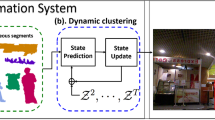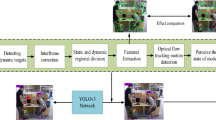Abstract
Robust automatic workflow monitoring using visual sensors in industrial environments is still an unsolved problem. This is mainly due to the difficulties of recording data in work settings and the environmental conditions (large occlusions, similar background/foreground) which do not allow object detection/tracking algorithms to perform robustly. Hence approaches analysing trajectories are limited in such environments. However, workflow monitoring is especially needed due to quality and safety requirements. In this paper we propose a robust approach for workflow classification in industrial environments. The proposed approach consists of a robust scene descriptor and an efficient time series analysis method. Experimental results on a challenging car manufacturing dataset showed that the proposed scene descriptor is able to detect both human and machinery related motion robustly and the used time series analysis method can classify tasks in a given workflow automatically.
Access this chapter
Tax calculation will be finalised at checkout
Purchases are for personal use only
Preview
Unable to display preview. Download preview PDF.
Similar content being viewed by others
References
Adam, A., Rivlin, E., Shimshoni, I., Reinitz, D.: Robust real-time unusual event detection using multiple fixed-location monitors. PAMI 30, 555–560 (2008)
Boiman, O., Irani, M.: Detecting irregularities in images and in video. In: Proc. ICCV (2005)
Breitenstein, M., Grabner, H., Gool, L.V.: Hunting nessie: Real time abnormality detection from webcams. In: Proc. ICCV Workshop on Visual Survaillance (2009)
Felzenszwalb, P., McAllester, D., Ramanan, D.: A discriminatively trained, multiscale, deformable part model. In: Proc. CVPR (2008)
Grabner, H., Bischof, H.: On-line boosting and vision. In: Proc. CVPR, vol. 1, pp. 260–267 (2006)
Jaeger, H.: The “echo state” approach to analysing and training recurrent neural networks. Technical Report GMD Report 148, German National Research Institute for Computer Science (2001)
Jaeger, H.: Adaptive nonlinear system identification with echo state networks. In: Proc. NIPS, vol. 15, pp. 593–600 (2003)
Johnson, N., Hogg, D.: Learning the distribution of object trajectories for event recognition. In: Proc. BMVC (1996)
Huang, C., Wu, D., Nevatia, R.: Robust Object Tracking by Hierarchical Association of Detection Responses. In: Forsyth, D., Torr, P., Zisserman, A. (eds.) ECCV 2008, Part II. LNCS, vol. 5303, pp. 788–801. Springer, Heidelberg (2008)
Li, J., Gong, S., Xiang, T.: Scene segmentation for behaviour correlation. In: Forsyth, D., Torr, P., Zisserman, A. (eds.) ECCV 2008, Part IV. LNCS, vol. 5305, pp. 383–395. Springer, Heidelberg (2008)
Makris, D., Ellis, T.: Learning semantic scene models from observing activity in visual surveillance. Trans. on Systems, Man, and Cybernetics 35, 397–408 (2005)
Lv, F., Nevatia, R.: Recognition and segmentation of 3-D human action using HMM and multi-class adaBoost. In: Leonardis, A., Bischof, H., Pinz, A. (eds.) ECCV 2006. LNCS, vol. 3954, pp. 359–372. Springer, Heidelberg (2006)
Ozturk, M.C., Xu, D., Principe, J.C.: Analysis and design of echo state networks. Neural Computation 19, 111–138 (2007)
Padoy, N., Mateus, D., Weinland, D., Berger, M., Navab, N.: Workflow monitoring based on 3d motion features. In: Proc. ICCV/WS on Video-oriented Object and Event Classification (2009)
Scherer, S., Oubbati, M., Schwenker, F., Palm, G.: Real-time emotion recognition from speech using echo state networks. Artificial Intelligence, 205–216 (2008)
Skowronski, M., Harris, J.: Automatic speech recognition using a predictive echo state network classifier. Neural Networks 20, 414–423 (2007)
Stauffer, C., Grimson, W.: Adaptive background mixture models for real-time tracking. In: Proc. CVPR, vol. 2, pp. 246–252 (1999)
Wang, X., Ma, K., Ng, G., Grimson, W.: Trajectory analysis and semantic region modeling using a nonparametric bayesian model. In: Proc. CVPR (2008)
Zhong, H., Shi, J., Visontai, M.: Detecting unusual activity in video. In: Proc. CVPR (2004)
Author information
Authors and Affiliations
Editor information
Editors and Affiliations
Rights and permissions
Copyright information
© 2011 Springer-Verlag Berlin Heidelberg
About this paper
Cite this paper
Veres, G., Grabner, H., Middleton, L., Van Gool, L. (2011). Automatic Workflow Monitoring in Industrial Environments. In: Kimmel, R., Klette, R., Sugimoto, A. (eds) Computer Vision – ACCV 2010. ACCV 2010. Lecture Notes in Computer Science, vol 6492. Springer, Berlin, Heidelberg. https://doi.org/10.1007/978-3-642-19315-6_16
Download citation
DOI: https://doi.org/10.1007/978-3-642-19315-6_16
Publisher Name: Springer, Berlin, Heidelberg
Print ISBN: 978-3-642-19314-9
Online ISBN: 978-3-642-19315-6
eBook Packages: Computer ScienceComputer Science (R0)




